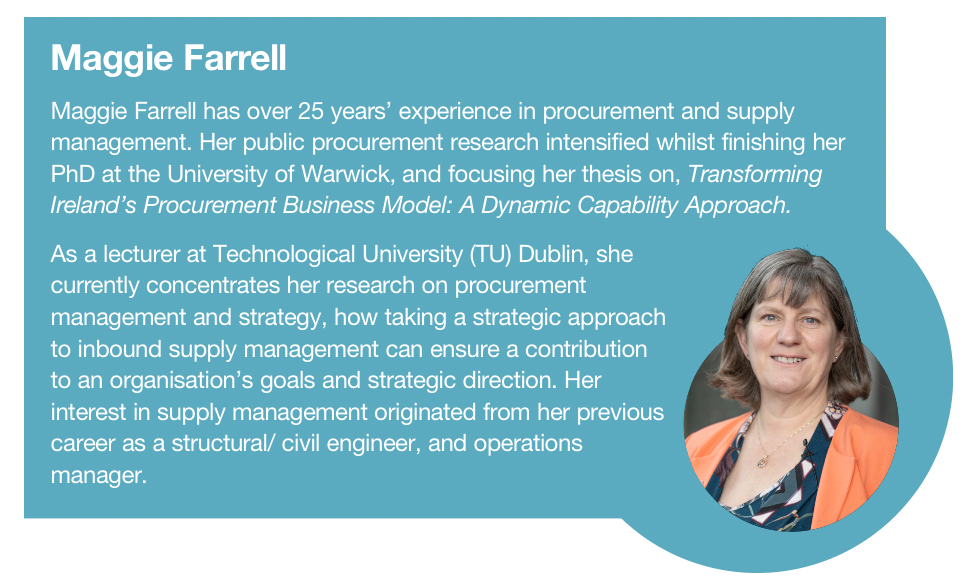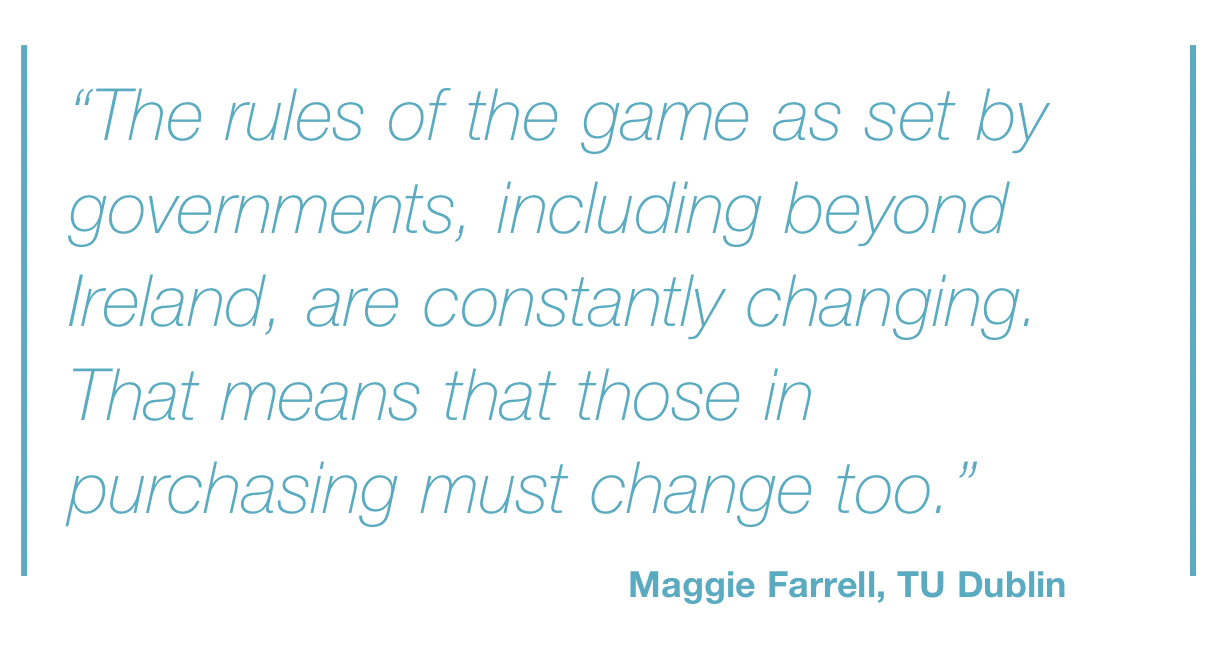Five enablers of public procurement evolution

Senior lecturer at TU Dublin in strategic supply management, Maggie Farrell, discusses the need for technical and evolutionary change within public procurement’s business model.
Farrell’s research on Ireland’s public procurement evolution found that the business model requires systemic change to help overcome inertia and drive the evolution of its capabilities, routines, and processes. To deliver this progression, the TU Dublin lecturer outlines five enablers of change. These are:
- political and leadership buy-in and drive.
- centre-led procurement, with one voice.
- a procurement network governance structure.
- procurement practices and operations; and
- stakeholder engagement for professional procurement practice.
Farrell advocates for a centre-led shared service procurement network business model to assist public procurement management. This network focuses on delivering best practice procurement to deliver on government goals and objectives. The overall objective, she explains, is to balance supply and demand “effectively and efficiently” across public sector stakeholders.
To achieve the Office of Government Procurement’s vision of transparent, accessible, responsive, and sustainable public procurement, Farrell indicates that the current business model requires “cooperation, coordination, trust, data sharing, visibility, open communication, management accountability, and oversight”.
“If you are to deliver best practice public procurement, there is a need for enhanced collaboration and cohesion.” This is made possible by shared policies, systems, processes, data management, and common governance.
The business model outlined in her research represents this logic and articulates how the procurement function should operate. Within this, Farrell draws on the importance of capabilities and focuses specifically on “dynamic capabilities” or “processes that recognise the need for regular evolution of routines and processes”.
Enablers
Sensing is the first dynamic capability processes to enable change. It encompasses processes which enable leaders to recognise the need for procurement change. “Before the economic crash and before the ‘Troika’, I scrutinised different reports and there was little mention of procurement,” she reflects, adding: “In the aftermath, we observed an exponential increase in reports with a major focus on procurement.” Farrell explains that during that time, capability monitoring ensured that there was a greater recognition that procurement could deliver balance across supply and demand, while also delivering on government policy.
The second key enabler, seizing, requires leaders to make decisions on an aligned strategic vision regarding procurement change. “The second stage is the requirement for a centre-led model with shared networks. That is what is required to sell and be quite clear about what that means, so everyone has an opportunity to be on the same page,” Farrell adds.
Reconfiguring the business model, the third enabler, requires two sets of dynamic capability processes, which respond to the need to organise for shared engagement to deliver cultural and structural reconfiguration. “Shared engagement is an absolute. Every organisation has different organisational logics and diverse cultures. It is essential that this is considered,” she says. Secondly reconfiguring processes also focus on delivering on accountable process ownership to enable process reconfiguration.
The fourth change enabler requires key central actors of share service networks to ‘enable and orchestrate asset reconfiguration’. “Leaders and managers that can manage that change and effectively reconfigure the chessboard are essential. Best practice public sector procurement will not happen without networking, communication, and social skills. It is also about leaders and assisting in the change,” Farrell explains.
The final key enabler is collaborative knowledge management. Farrell observes that there is a need for “evolutionary fitness” to keep up with the external environment, alongside “technical fitness” relating to best practice purchasing and what that entails regarding business models.
“We have increased risks that were not there before, including sustainability, climate change, advancement in technology, geopolitical turmoil – war, trade disputes, and economic turmoil – health and housing crises, and supply chain disruptions.
“The rules of the game as set by governments, including beyond Ireland, are constantly changing. That means that those in purchasing must change too.”
Farrell concludes by emphasising strategic supply management and recognising this is not “just about a buying process”. “It is about managing that supply chain and recognising who is that ‘contract manager’ and who has the relevant roles, as there needs to be more flexibility and agility going forward.
“There are so many things that are happening now that we need to consider going forward,” she asserts.







